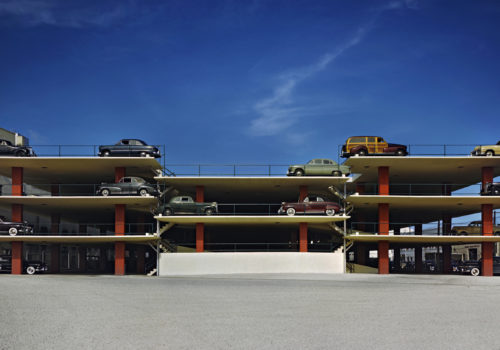Over the course of half a century, the American photographer Ezra Stoller documented the architecture of his country with the precision of a specialist in scale models. He frames the objects and buildings with the same acuity, playing with the lines and lighting, defying the rules of the third dimension. The background and foreground have magically merged; depth of field has ceased to exist in this world, flat as the earth before we discovered its curvature. Stoller’s maquette-like photographs don’t require modern retouching techniques. They share something immutable that can only be handled with subtlety: the mathematics of the image.
In these collages of bricks, cement and glass, man is relegated to a supporting role, appearing only furtively, like a figurine. His actions mean little in this world. As in the photograph “John Hancock Chicago construction, Skidmore Owings & Merrill, Chicago, 1967” where the silhouette of a construction worker teeters across a maze of metal beams. Only color gives these little puppets life.
Ezra Stoller’s America comes mainly in black and white, and with it the whole postwar landscape: construction sites, hydroelectric dams, factories and famous buildings. This is a bygone America, one that seems almost unreal. Each building is lit with dreamy white light, giving an eternal dimension to the textures of the images. There are more than 50,000 photographs in the archives, many of which have proved influential. One thing is undeniable: Ezra Stoller, who died in 2004, depicted American architecture of the 20th century with a vision that still seems modern today.
Jonas Cuénin
Ezra Stoller, Beyond Architecture
Until March 2nd, 2013
Yossi Milo Gallery
245 10th Ave
New York, NY 10001
USA
(212) 414-0370
Book
Ezra Stoller – Photographer
Yale University Press
288 pages, $50
ISBN 978-0-300172-37-9
















